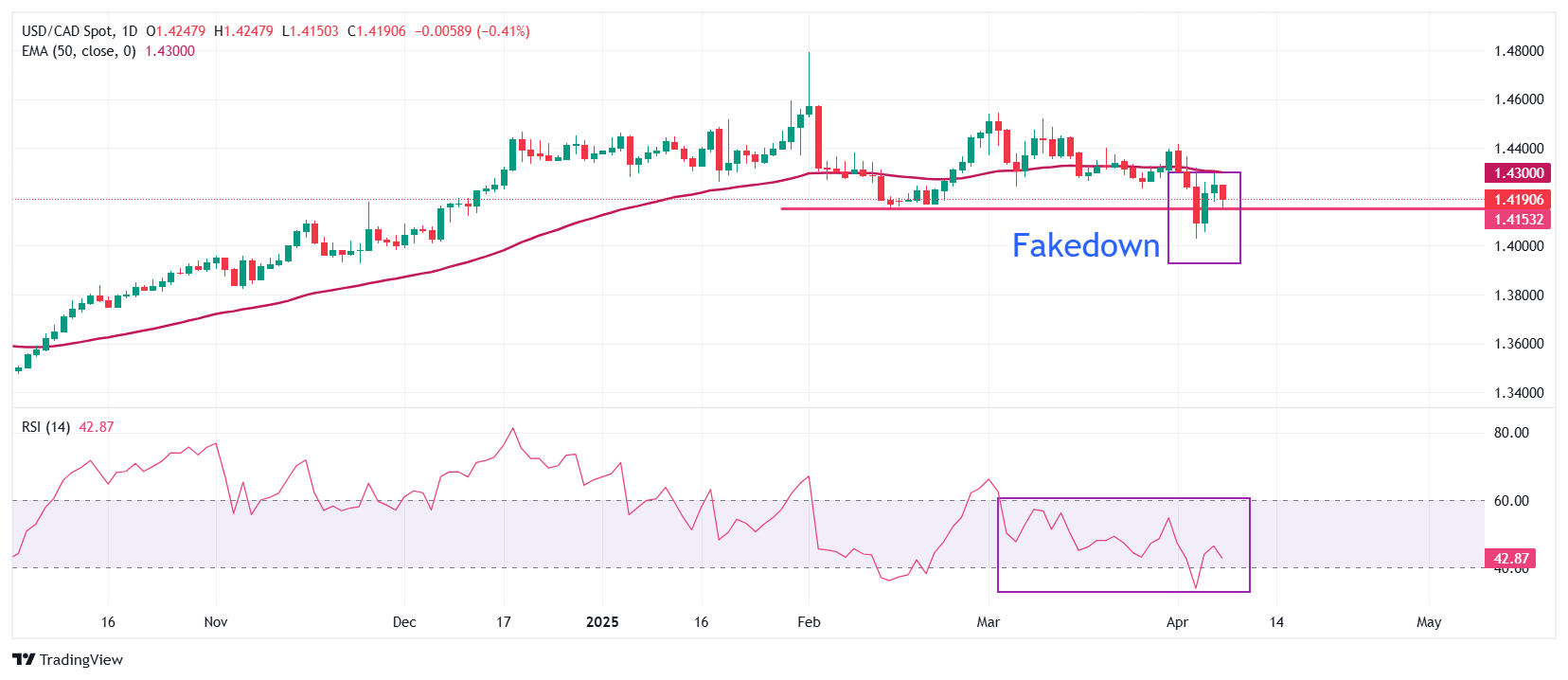USD/CAD Price Forecast: Slumps below 1.4200
- USD/CAD tumbles below 1.4200 as the US Dollar takes a hit on escalating US recession fears.
- JP Morgan expects the US economy to contract by 0.3% this year.
- Canadian PM Carney warned that the US recession could have a negative impact on the domestic economy.
The USD/CAD pair fall sharply below the key level of 1.4200 in Tuesday’s European session. The Loonie pair weakens as the US Dollar (USD) faces selling pressure amid fears that the United States (US) economy could enter a recession due to the imposition of harsh-than-expected tariffs by President Donald Trump.
Trump announced reciprocal tariffs on Wednesday in addition to a 10% universal baseline levy, whose burden is expected to be borne by US importers. Theoretically, importers will pass on the impact of higher prices to consumers. Such a scenario will be inflationary and slow down the domestic economic growth by diminishing the purchasing power of households.
Fears of potential US economic shocks have led market experts to revise their growth forecasts. Investment banking firm JP Morgan has forecasted that the US economy could end the year with a 0.3% decline in the Gross Domestic Product (GDP) growth.
Meanwhile, the Canadian Dollar (CAD) trades higher against the US Dollar, but its outlook remains uncertain as the probability of the Canadian economy to enter a recession has swelled. Canadian Prime Minister (PM) Mark Carney said on Monday that President Donald Trump’s tariffs have increased the possibility of a US recession, and that will have a major “negative effect on the Canadian economy”.
USD/CAD recovers strongly after a “fake” breakdown of the 1.4150 support plotted from the February 14 low. The near-term outlook of the Loonie pair is still bearish as the 50-day Exponential Moving Average (EMA) is acting as a major barricade around 1.4300.
The 14-day Relative Strength Index (RSI) holds the key level of 40.00. A fresh bearish momentum would trigger if the RSI fails to hold the 40.00 level.
The pair would strengthen if it breaks above the April 3 high of 1.4320. Such a scenario would send the major higher to near the April 1 high of 1.4415 and the March 14 high of 1.4447.
On the flip side, a fresh downside would appear if the pair breaks below the December 6 low of 1.4020. The scenario would expose the pair to the psychological support of 1.4000, followed by the November 25 low of 1.3927.
USD/CAD daily chart

a
Canadian Dollar FAQs
The key factors driving the Canadian Dollar (CAD) are the level of interest rates set by the Bank of Canada (BoC), the price of Oil, Canada’s largest export, the health of its economy, inflation and the Trade Balance, which is the difference between the value of Canada’s exports versus its imports. Other factors include market sentiment – whether investors are taking on more risky assets (risk-on) or seeking safe-havens (risk-off) – with risk-on being CAD-positive. As its largest trading partner, the health of the US economy is also a key factor influencing the Canadian Dollar.
The Bank of Canada (BoC) has a significant influence on the Canadian Dollar by setting the level of interest rates that banks can lend to one another. This influences the level of interest rates for everyone. The main goal of the BoC is to maintain inflation at 1-3% by adjusting interest rates up or down. Relatively higher interest rates tend to be positive for the CAD. The Bank of Canada can also use quantitative easing and tightening to influence credit conditions, with the former CAD-negative and the latter CAD-positive.
The price of Oil is a key factor impacting the value of the Canadian Dollar. Petroleum is Canada’s biggest export, so Oil price tends to have an immediate impact on the CAD value. Generally, if Oil price rises CAD also goes up, as aggregate demand for the currency increases. The opposite is the case if the price of Oil falls. Higher Oil prices also tend to result in a greater likelihood of a positive Trade Balance, which is also supportive of the CAD.
While inflation had always traditionally been thought of as a negative factor for a currency since it lowers the value of money, the opposite has actually been the case in modern times with the relaxation of cross-border capital controls. Higher inflation tends to lead central banks to put up interest rates which attracts more capital inflows from global investors seeking a lucrative place to keep their money. This increases demand for the local currency, which in Canada’s case is the Canadian Dollar.
Macroeconomic data releases gauge the health of the economy and can have an impact on the Canadian Dollar. Indicators such as GDP, Manufacturing and Services PMIs, employment, and consumer sentiment surveys can all influence the direction of the CAD. A strong economy is good for the Canadian Dollar. Not only does it attract more foreign investment but it may encourage the Bank of Canada to put up interest rates, leading to a stronger currency. If economic data is weak, however, the CAD is likely to fall.

